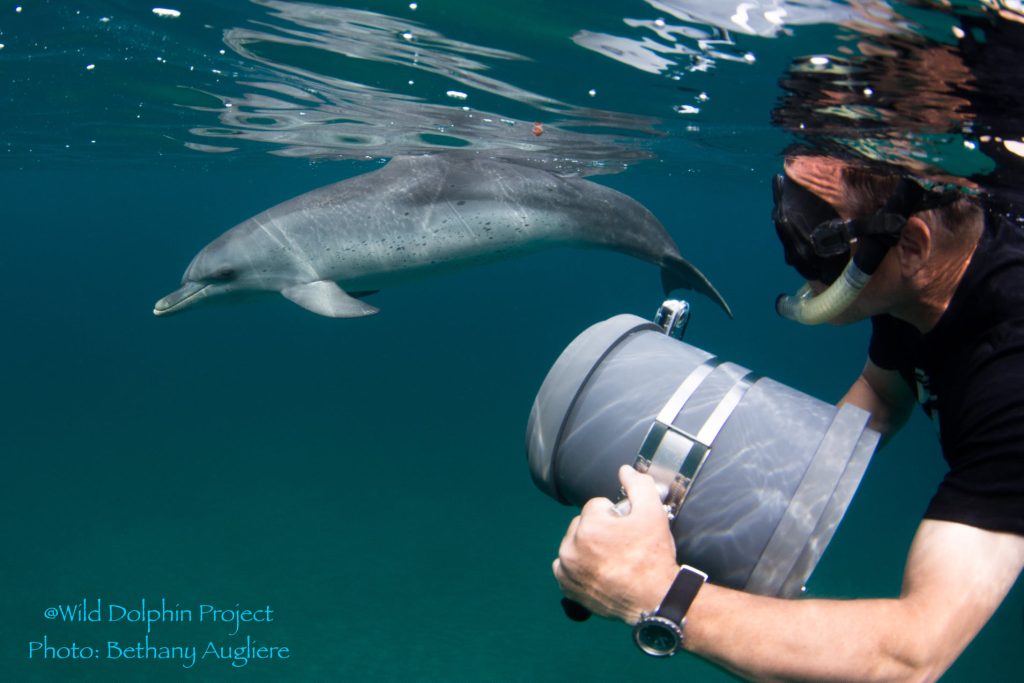The Wild Dolphin Project, founded by Denise Herzing, Ph.D., studies the behavior and communication of two species of dolphins in the Bahamas. Since 1985, we have made discoveries about their social relationships, feeding behavior, communication, movement patterns, genetics, life history and more.
To do our work, we spend months in the field every summer watching and observing the dolphin behavior from the surface and in the water, identifying and tracking individuals over time with video and photos, collecting DNA with fecal samples and collecting underwater sound signals.
While the basics of how we research dolphins in the Bahamas have stayed the same, technology has certainly changed how we do our research and what we can accomplish. It makes a lot of our work quicker and faster, and technology has given us tools to study the dolphins in new ways and answer more questions.
In the last decade, we’ve expanded our use of technology to collect data and learn more than ever about these animals, including the use of drones, passive acoustic monitoring, underwater computers called CHAT (Cetacean Hearing and Telemetry) and an underwater sound localization device, called ASPOD.
Read on to learn more specifics about these changes.
Video and Sound
Our research equipment has evolved over the decades, allowing us more efficient processing for photographs and video, as well as new perspectives both underwater and aerially.
In our early years, we worked with an underwater Nikonos camera and film. With a limited number of shots, 36, and processing facilities on land, our slides would take a few trips to be returned and labeled. In the meantime, we kept a “sketchbook” so we could at least sketch our marks and notches of regular dolphins we were seeing.
Now, we can take essentially unlimited photos and video and process them during the trip. We download the photos off the cameras each night, and work on labeling them. We also download video and do an initial watch of the video of the day in the evening, and log individuals, behaviors and sounds while it is fresh in our minds.
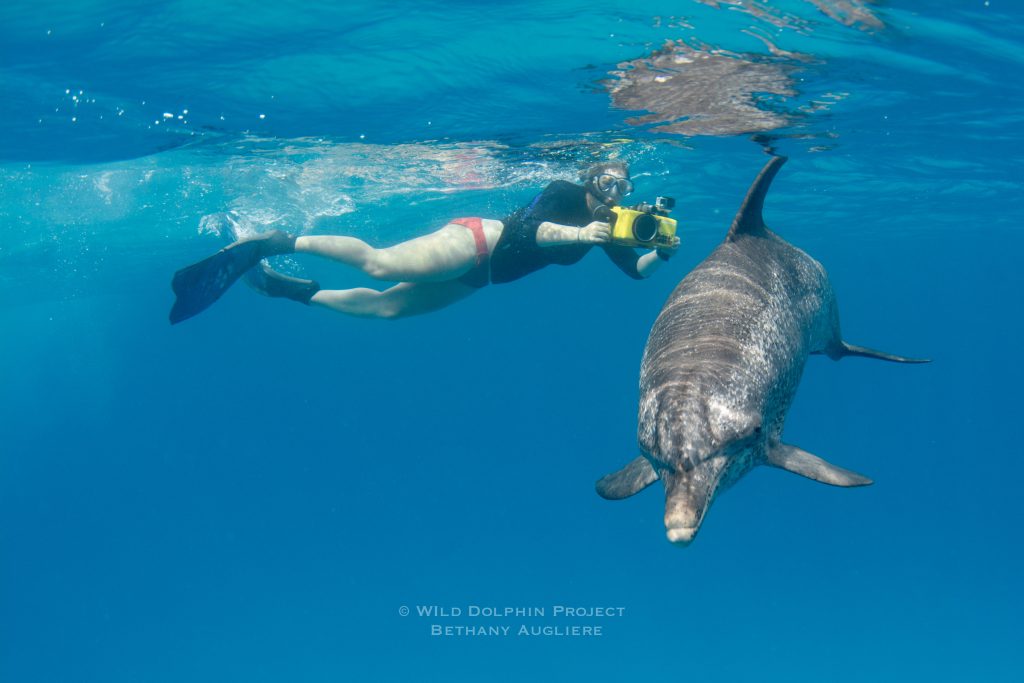
Researcher recording underwater video and sound.
CHAT – CETACEAN HEARING AND TECHNOLOGY
The Atlantic spotted dolphins in the Bahamas are curious of people and often engage in interactive ways, even mimicking our behavior! If we would dive down to the seafloor and rest our elbows in the sand, they would follow and lay in the sand.
In the late 1990’s, Denise Herzing, Ph.D., founder and research director of WDP, began to explore what she called Phase 2 of the work. She would try to design a two-way communication system between humans and dolphins. The early vision and version was rudimentary, utilizing a mobile keyboard with visual and acoustic symbols for the dolphins to access. Later, when technology was evolving WDP was able to actually build, and use, an underwater computer which used real-time sound recognition to model more of what the dolphins were really doing — CHAT (Cetacean Hearing Augmentation Technology), developed by Thad Starner, Ph.D., and his team at Georgia Tech.
CHAT receives sounds via two underwater microphones, called hydrophones, and produces sounds through an underwater speaker. Under the direction of Denise, and with the help of colleagues Adam Pack, Ph.D. and Fabienne Delfour, Ph.D., WDP created a few basic artificial sounds, specifically whistles, outside of the dolphins natural repertoire, to label a few play objects, such as Sargassum seaweed, which is a natural play toy in their environment, as well as toys that we humans bring in the water, like scarf and rope.
With time, we also incorporated machine learning to train the computer housed on our bodies to recognize if dolphins mimicked our computer-generated whistles.
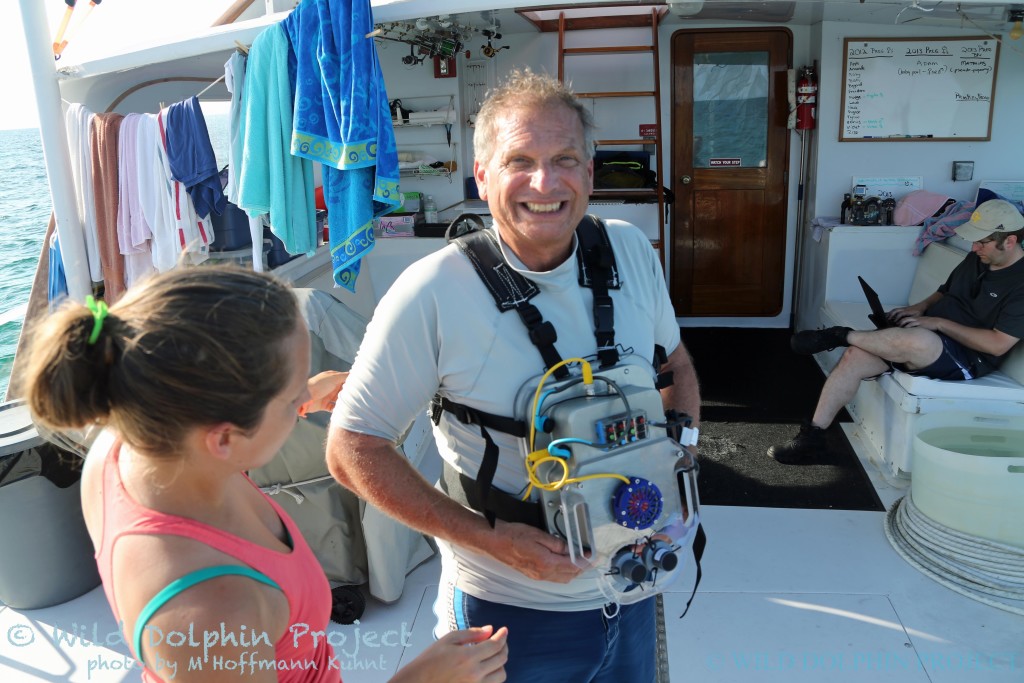
Adam Pack, Ph.D., full professor at the University of Hawaii at Hilo and long-time colleague of the Wild Dolphin Project, wears a CHAT box prior to entering the water. Georgia Tech team members check the device physically, and via computer, before the system goes in the water.
ASPOD
Our colleague, Matthias Hoffmann-Kuhnt, Ph.D., has developed ASPOD (Acoustic Source Position Overlay Device).
“Sound is one of the most important modes of communication for animals living in the ocean since light only travels for several tens of meters (if the visibility is good) while sound can travel thousands of kilometers (depending on the frequencies) underwater,” according to Hoffmann-Kuhnt. The issue with studying sound and vocalizations in marine mammals is identifying the vocalizer when the video/hydrophone system.
To address the issue, Hoffmann-Kuhnt developed ASPOD, which uses an underwater camera with three synchronized audio channels. Since the audio channels are synchronized, any sounds produced by dolphins will have different arrival times between the three hydrophones that are separated at fixed distances of about 60 cm in a triangular array on the underwater system and camera.
DRONES
Drones have given us the chance to study the dolphins from an entirely new perspective.
One of our researchers, Liah Mcpherson, a certified FAA drone pilot, began a study while an undergraduate at UNC Chapel Hill to assess effectiveness of studying dolphin behavior from drones.
In her abstract, she writes, “studying the behavior of small cetaceans can inform the understanding of their habitat use, social structure, and health, providing insight necessary for the conservation and management of these animals and their environment. Complications with such research arise due to the limited effectiveness of vessel-based observation. In particular, visually observing cetaceans in a manner which allows researchers to accurately track the behavior of individuals within a group is challenging. We address this issue by assessing the effectiveness of small unmanned aerial systems (UAS) for measuring behavior. In collaboration with the Wild Dolphin Project.”
McPherson conducted 6 UAS flights during 2018 to record preliminary data of traveling and socializing Atlantic spotted dolphins (Stenella frontalis) in the Northern Bahamas. Dolphins displayed no indication of disturbance by the UAS. During video review, she documented 19 different behaviors and identified many individual dolphins, suggesting that UAS will be effective in future studies that require acute awareness of individuals’ behavior.
“UAS has the potential to advance the study of small cetacean behavior, allowing more detailed observation of individuals in group settings. We anticipate UAS technology becoming more prevalent in both our continuing research, and that of other marine mammal scientists.”
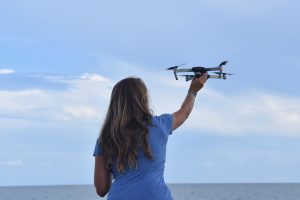
PASSIVE ACOUSTIC MONITORING
Researchers all over the world have turned to Passive Acoustic Monitoring (P.A.M.) as a technique to record underwater audio signals from marine mammals. PAM systems are typically deployed and sit on the bottom or hang in the water column attached to the bottom at various depths. Basically, the system is “triggered” to turn on and record when a certain frequency of sound is heard. With today’s technology, it is possible to record continuously and store data, or sample periodically for even longer periods of time. The researcher then retrieves the stored data in the unit, and can look at how often certain species of cetaceans go by, and what signals they produced.
Because half of our resident dolphins on Little Bahama Bank (LBB) left in 2013, we chose to deploy two Ecological Acoustic Recorders E.A.R.s on Little Bahama Bank. Although we still monitor this study site, we now split our time between LBB and Great Bahama Bank (GBB) further to the south where our previously resident group now lives, in addition to other local dolphins.
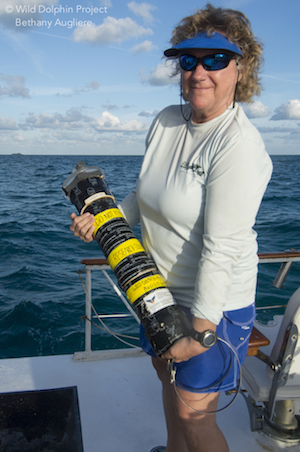
Dr. Herzing holding the E.A.R.
As we continue to do research in the Bahamas, we are sure to add novel technology that will enable us to answer more questions in new ways. So stay tuned!
More about ASPOD here.
Read Liah’s thesis on using drones to study dolphins here.
Read more about our latest drone study here.
Read more about E.A.R.S here.

